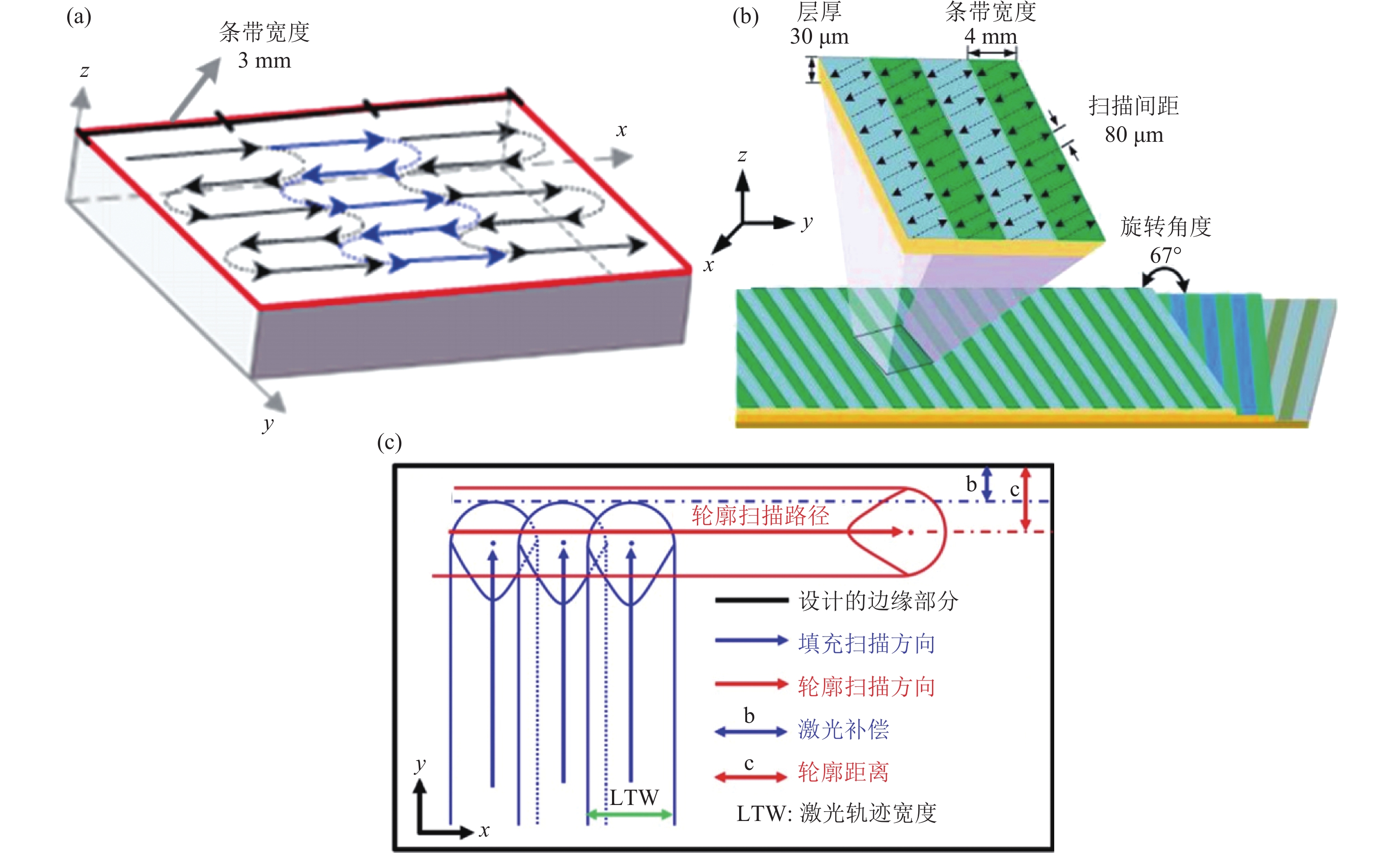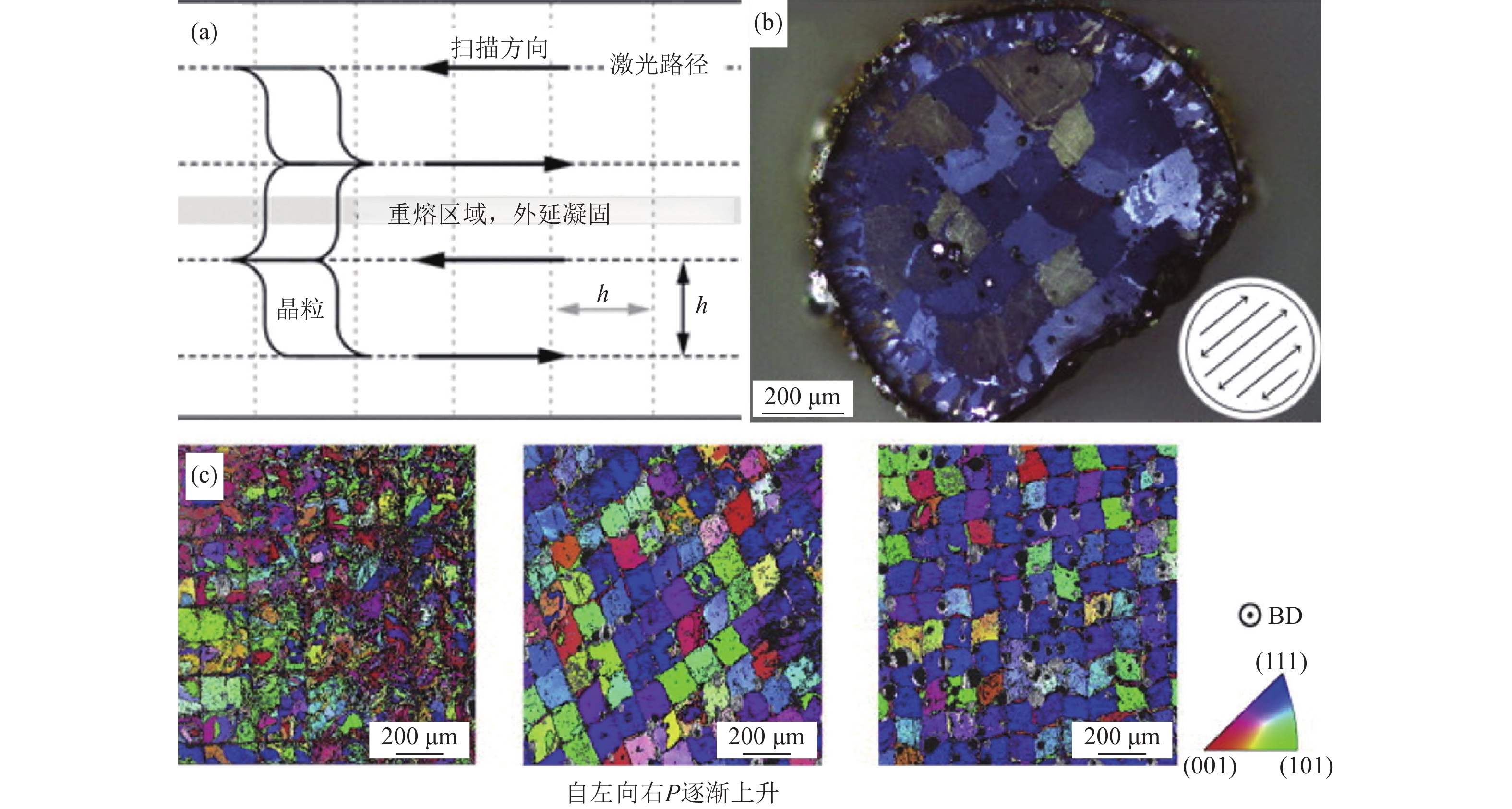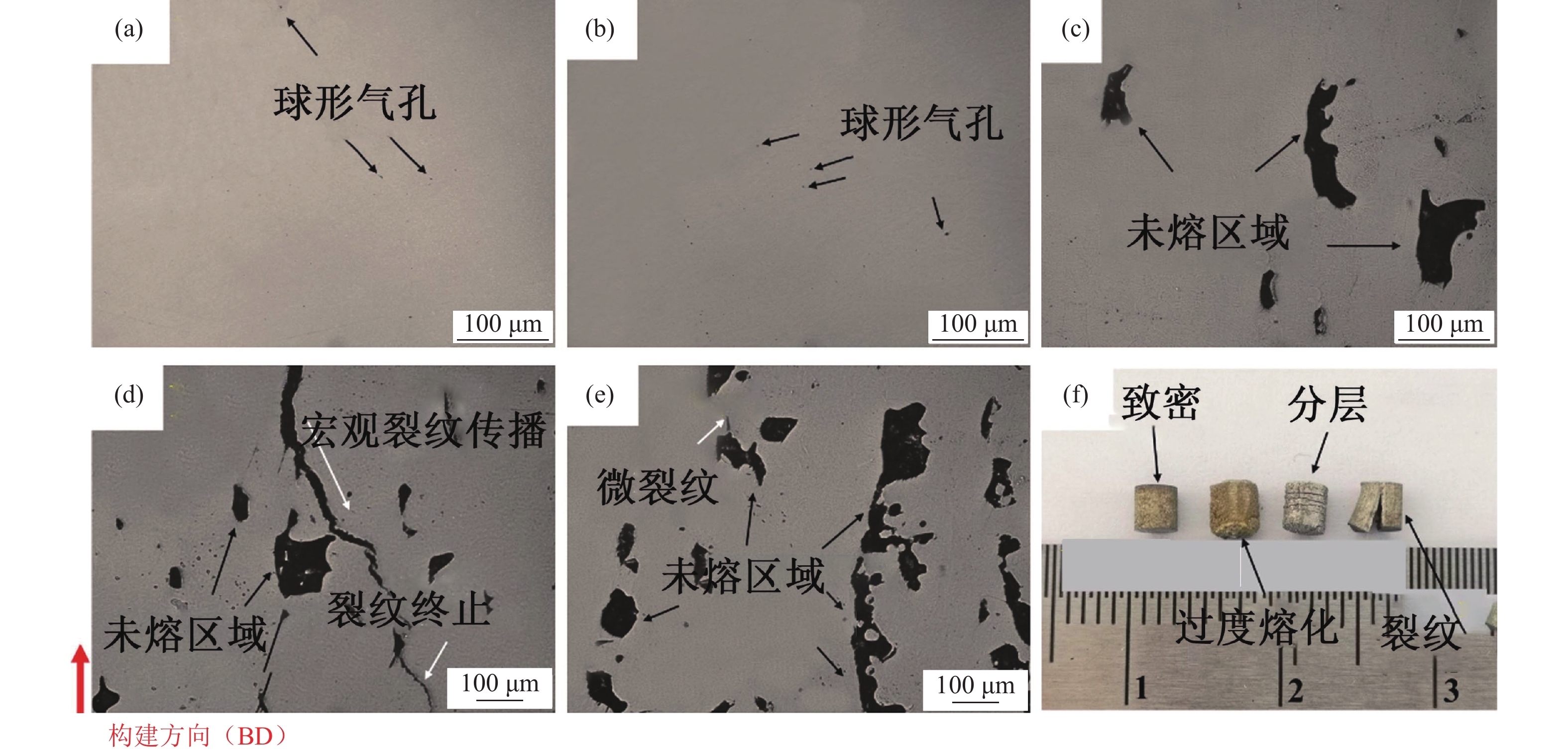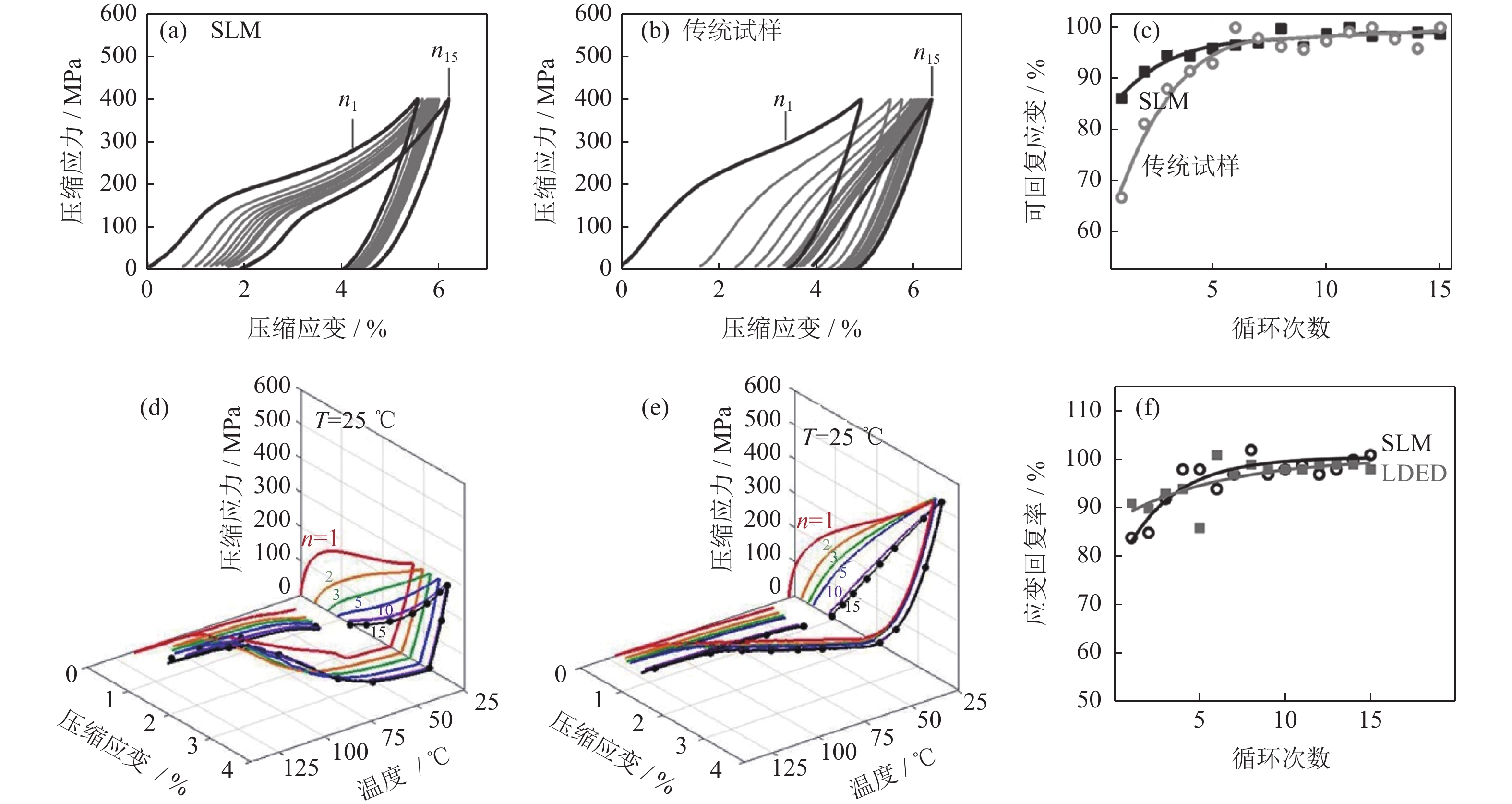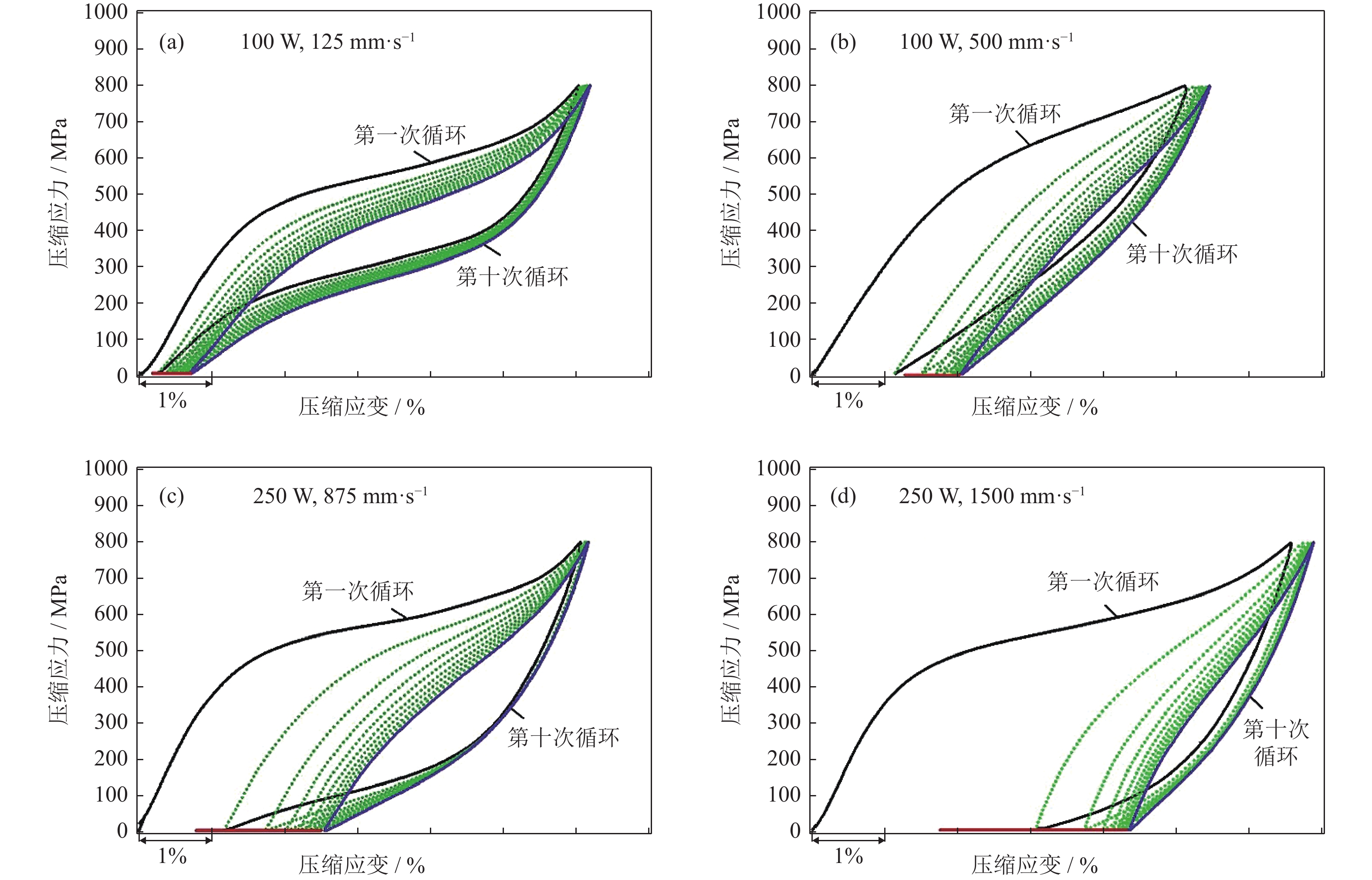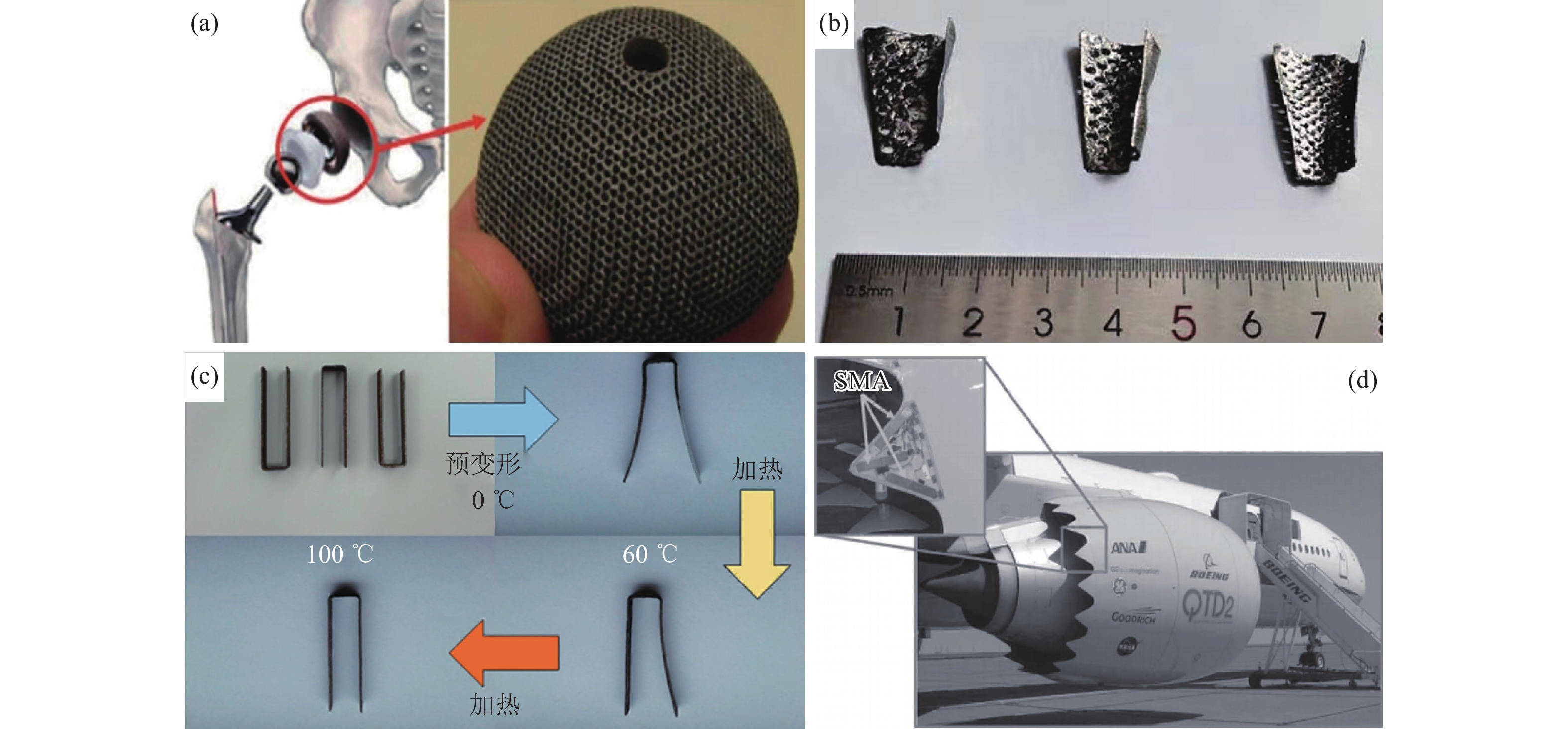-
摘要: NiTi作为一种形状记忆合金,具有优异的形状记忆效应、超弹性、耐腐蚀性、生物相容性,在生物医用、航空航天、微机电等领域均有着广泛的应用。增材制造(additive manufacturing,AM)技术作为一种新兴的加工方式,能够提高NiTi合金加工效率,并扩展NiTi合金应用领域。本文介绍了近年来国内外增材制造NiTi合金的研究进展,主要包括增材制造加工过程中原料及工艺的选择,熔池、晶粒、析出物、缺陷等的组织特点,原料、工艺参数、热处理对增材制造NiTi合金力学性能、相变温度、形状记忆效应、超弹性、表面质量的影响。最后对增材制造NiTi合金的研究现状进行了总结,展望了未来的发展趋势。Abstract: As a kind of shape memory alloys, the NiTi alloys show the excellent shape memory effect, superelasticity, corrosion resistance, and biocompatibility, which have been widely used in the biomedical, aerospace, and micro electro mechanical fields. Additive manufacturing (AM) as the new processing method can enhance the manufacturing efficiency of the NiTi alloys and broaden the applications. The research progress of the NiTi alloys fabricated by additive manufacturing was reviewed in this paper, including the selections of raw materials and process, the microstructural characteristics of molten pool, grain, precipitates, and defects, the effects of raw materials, processing parameters, and heat treatment on the mechanical properties, phase transformation temperature, shape memory effect, superelasticity, and surface quality. Finally, the research status of the NiTi alloys fabricated by additive manufacturing was summarized, and the perspectives for the future research in this area were presented.
-
Keywords:
- NiTi alloys /
- shape memory alloys /
- additive manufacturing /
- phase transformation /
- microstructure /
- properties
-
流动温压工艺是在温压工艺的基础上,结合粉末注射成形工艺的优点而发展的一种近净成形技术[1–3]。粉末在温压状态下的流动性是获得高性能粉末冶金零件的关键因素,粉末中添加的黏结剂在加热条件下转变为黏流态,黏流态的黏结剂在压制力的作用下带动粉末流动,从而大大提高了粉末填充能力和成型性,因此流动温压工艺既具有温压工艺成形高密度零件的特点[4],又能像注射成形一样成形形状复杂的零件,是一项极具潜力的新技术[5]。
黏结剂一般由低分子物质、高分子物质及必要的添加剂组成,通常加入质量分数为1%~6%。虽然黏结剂的加入能够提高粉末的流动性,但烧结过程中,高分子黏结剂的分解会在烧结坯内部留下大量孔隙,孔隙的存在会降低零件烧结密度和力学性能,因此对脱脂工艺进行研究非常有必要[6]。流动温压工艺黏结剂用量远低于注射成形工艺,通常不需要专门的脱脂工序,直接采用热脱脂的方法可以实现脱脂、烧结一体化。目前对粉末热脱脂的研究多集中在注射成形上,赵利刚和周时宇等[7–8]研究认为只要脱除质量分数4%左右的黏结剂,试样中就会形成初始孔隙,随着新的孔隙在内表面不断形成,试样内部形成连通孔隙。李永,陈慧和郑军君等[9–11]发现流动温压工艺热脱脂关键在于控制低温阶段升温速度。
本文使用石蜡基聚合物作为铁基粉末流动温压工艺的黏结剂,采用热重分析法(thermogravimetric analysis,TGA)研究黏结剂在N2气氛下的脱脂过程,通过微分法计算脱脂反应动力学参数,确定热脱脂升温速率,制订合理的脱脂和烧结工艺。
1. 实验材料及方法
实验原料选用山东莱芜奥星生产的316L水雾化铁粉,混合金属粉末成分与粒度见表 1所示。采用石蜡基聚合物作为黏结剂,各组元熔点和成分见表 2。
表 1 实验用金属粉末的成分与粒度Table 1. Composition and particle sizes of the raw powders粉末 粒度/μm 质量分数/% 水雾化铁粉 ≤147 78.5 羟基铁粉 5 20.0 还原钼粉 ≤75 0.5 石墨粉 ≤75 1.0 表 2 黏结剂组元热解温度和成分Table 2. Thermal characteristic and composition of binder components组元 熔点/ ℃ 热分解温度/ ℃ 质量分数/ % 聚酰胺(PA) 170.6 316.6~500.5 65.0 聚乙烯蜡(PE) 113.1 192.3~480.9 17.5 普通石蜡(PW) 64.7 180.1~307.0 17.5 将金属粉末和黏结剂按各自成分混合好,再加入适量的溶剂,将黏结剂(质量分数6%)和金属粉末(质量分数94%)进行湿混,直到溶剂差不多完全挥发为止;将湿混后的粉末在50 ℃下干燥2 h,防止黏结剂固化;将干燥好的粉末研磨,过100目筛;将过筛后的预混合粉末再次混合1 h得到预混合粉末。利用十字腔模具在CMT 5105型万能材料拉伸机上将预混合粉末压制成十字生坯,压制温度163 ℃,压制速度250 mm/min,压制压力600 MPa。
利用Netszh STA449热分析仪对生坯试样和纯黏结剂体系分别进行热重分析,得到相应的热重–微商热重曲线(thermogravimetry–derivative thermogravimetry,TG–DTG);采用排水法来测定试样生坯和烧结坯密度;烧结收缩率根据国家标准GB/T5159-1985计算;利用光学显微镜进行微观结构分析,试样观察面选择与压制方向垂直的表面。
2. 结果与讨论
2.1 脱脂过程失重分析
对纯黏结剂和生坯进行热重分析,升温速率分别为2、5、8、11 ℃·min-1,得到相应的热重曲线如图 1所示。图 1(a)是纯黏结剂在升温速率为11 ℃·min-1下的热重曲线,可以观察到曲线明显分为两个失重阶段,第1阶段是140~340 ℃,失重率为30.28%,对应的是低熔点石蜡和部分聚乙烯蜡的分解;第2段的热解区间为340~480 ℃,主要是高熔点组元聚酰胺以及部分聚乙烯蜡的分解,其失重率为66.33%。分析可见,纯黏结剂失重区间主要集中在高温脱脂段,低温脱脂段组元失重少,分解平缓,分解温度区间大。这种特点有利于保持脱脂坯形状,较少或不产生脱脂缺陷。
图 1(b)是添加质量分数6%黏结剂的生坯在升温速率为11 ℃·min-1下热重曲线,与纯黏结剂热重曲线比较可见,生坯曲线的失重比较平稳,有利于控制缺陷的产生。生坯最大失重速率出现在400 ℃附近,与其对应的纯黏结剂的最大失重速率出现在460 ℃附近,大约提前了60 ℃。这种差异起因于生坯中金属粉末的加入有效降低了黏结剂分子间的联结程度,起到了分散、隔离与催化的作用,使得生坯黏结剂的脱除通道较纯黏结剂更为畅通。
2.2 热重曲线动力学分析
对生坯不同升温速率下的热重曲线进行一阶微分处理,可以得到相应的微商热重(derivative thermogravimetry,DTG)曲线,如图 2示。微商热重曲线反映了脱脂速率的瞬时变化情况,随着升温速率的增加,相应的瞬时脱脂速率上升,曲线峰谷向高温方向移动,但曲线的形状没有发生变化,且每条曲线都有两个峰谷对应两个分解阶段。
脱脂过程可以看作是聚合物热解反应气体逸出的过程,同时生坯的内部质量和传热可以忽略不计。一般反应速率微分方程如式(1)所示[12]。
$$\frac{{{\rm{d}}\alpha }}{{{\rm{d}}t}} = f(\alpha ) \cdot k(T)$$ (1) 式中:f(α)为机理函数的微分形式,α为转化率,t为时间,T为温度,k(T)为温度T下的反应速率常数。
根据阿累尼乌斯方程(Arrhenius)得出金属坯体脱脂反应速率方程,如式(2)所示[13]。
$$ k(T) = A \cdot \exp \left( { - E/RT} \right) $$ (2) 式中:A为指数前因子(频率因子),min-1;Ea为激活能,kJ·mol-1;R为普适气体常数,R = 8.314 [J·(mol·K)-1]。
由式(1)与式(2)结合Coats–Redfren方法[14–15]得出金属坯体脱脂反应动力学方程,如式(3)所示。
$$\ln \left[ {k(T)} \right] = \ln \left( {\frac{{AR}}{{\beta {E_{\rm{a}}}}}} \right) - \frac{{{E_{\rm{a}}}}}{{RT}}$$ (3) 式中:β为升温速率,℃·min-1,实验中为常数。
图 2为不同升温速率下生坯的微商热重曲线,有图可知,瞬时脱脂速率波动较大的区域对应两个分解阶段:第1阶段470~660 ℃(低温阶段),对应着普通石蜡的分解;第2阶段660~760 ℃(高温阶段),对应着高分子组元的分解。利用作图法分别得到两区域不同速率下的ln[k(T)]–T-1关系曲线,如图 3所示,通过拟合直线的截距和斜率可以计算得到指前因子(A)、激活能(Ea)以及拟合系数(r2),结果见表 3所示。
表 3 生坯脱脂过程动力学参数Table 3. Kinetic parameters of green compact with diffeent heating rates热解阶段 升温速率,β/(℃·min-1) 激活能,Ea/(kJ·mol-1) 指前因子,A / min-1 拟合系数,r2 第1阶段(低温阶段) 2 44.3 5.82×106 0.9954 5 31.3 0.96×106 0.9970 8 34.8 3.23×106 0.9916 11 31.6 1.94×106 0.9954 第2阶段(高温阶段) 5 56.3 1.45×108 0.9914 8 70.2 4.65×109 0.9937 11 72.7 1.14×1010 0.9938 从表 3可以看出,激活能在31.3~72.7 kJ·mol-1范围内,指前因子在0.96×106~1.14×1010 min-1。脱脂第1阶段的激活能整体上低于第2阶段,说明低分子组元更易脱除,故应严格控制升温速率,避免低分子组元脱除过快而产生大量气体形成鼓泡等缺陷。激活能随指前因子的增加而增加,表明反应对温度比较敏感[16]。
2.3 脱脂工艺优化
流动温压工艺的脱脂与烧结是一起进行的,本文仅探讨脱脂环节。保证脱脂质量的关键是控制第1阶段的升温速率,第1阶段低分子组元的脱除速率太快,通过蒸发、分解产生的气体无法及时从坯块内排出,当气体膨胀产生的力大于粉末颗粒之间的结合力时,就会导致缺陷的产生,图 4所示为脱脂坯出现的开裂、鼓泡等典型脱脂缺陷。根据表 3中生坯脱脂过程动力学参数,确定合理的热脱脂升温速率,改进脱脂工艺,图 5是优化后的脱脂工艺曲线。
2.4 试样烧结前后相关性能测试
在氮气气氛下采用优化后的热脱脂工艺对试样进行脱脂,然后在1300 ℃烧结1 h,随后冷却至室温得到完整烧结坯。测量和计算得到生坯密度、烧结坯密度和烧结收缩率,结果如表 4所示。由表 4可知,生坯经烧结后密度提高,存在一定的烧结收缩现象,且试样横向尺寸的烧结收缩率略大于轴向尺寸的烧结收缩率。烧结坯轴向部分受竖直方向压制力直接作用于粉末形成,横向部分是依靠粉末的流动挤压而形成的。随着压制力逐渐增大,轴向部分粉末发生机械咬合,如果粉末流动性不够理想,传递到横向部分的压力甚少,粉末无法充分变形,坯体内部存在较多孔洞,导致在烧结过程中横向部分有较大的收缩空间,且横向部分烧结后的孔隙数量比轴向部分多,如图 6烧结坯轴向上端和横向左端金相组织所示。利用线切割将试样切开分别测量各部分密度,结果如图 7所示,轴向部分的整体密度要高于横向部分,横向部位左右端密度最低。这与横向部分组织中含有较多的孔隙有关,可以通过适当提高黏结剂质量分数和粉末流动性来改善整体烧结密度。
表 4 生坯密度、烧结坯密度和烧结收缩率Table 4. Green density, sintered part density, and sintered part shrinkages生坯密度/ (g·cm-3) 烧结密度/ (g·cm-3) 烧结收缩率/% 轴向方向 轴向直径 横向方向 横向直径 5.971 6.720 -5.83 -0.27 -6.10 -0.31 3. 结论
(1)黏结剂热重分析表明,脱脂过程分为两个明显阶段:第1阶段470~660 ℃(低温阶段),对应着普通石蜡的分解;第2阶段660~760 ℃(高温阶段),对应着高分子组元的分解
(2)采用微分法计算脱脂过程动力学相关参数,建立脱脂过程动力学机理方程。结果表明,激活能在31.3~72.7 kJ·mol-1范围内,指前因子在0.96×106~1.14×1010 min-1;脱脂过程第1阶段的激活能整体上低于第2阶段,由此可得,保证脱脂质量的关键是控制第1阶段的升温速率。
(3)根据生坯脱脂过程动力学参数,经反复试验确定得到最佳脱脂工艺:室温~340 ℃,升温速率2 ℃/min,保温30 min;340~500 ℃,升温速率4 ℃/min,保温60 min,随后进入烧结环节。
(4)生坯经烧结后密度整体提高,且试样横向尺寸的烧结收缩率略大于轴向尺寸烧结收缩率。试样烧结坯横向部分的整体密度要低于轴向部分,横向部位左右端密度最低,微观组织呈现较多孔隙。
-
图 9 增材制造NiTi合金的应用:(a)右股骨髋关节的植入体[88];(b)口腔颌面修复的植入体;(c)增材制造NiTi合金在温度刺激下发生的形状变化[89];(d)可调节的喷嘴[4]
Figure 9. Applications of AM NiTi alloys: (a) hip implant for insertion into the right femur[88]; (b) implants for oral and maxillofacial restoration; (c) shape development stimulated under the various temperatures[89]; (d) adjustable serrated edge nozzle[4]
表 1 用于激光增材制造的粉末特性及工艺参数
Table 1 Powder properties and optimal processing parameters of the NiTi alloys by LAM
送给方式 文献 Ni原子数分数 / % 粒径 / μm P / W v / (mm·s‒1) h / μm t / μm E / (J·mm‒3) 铺粉 [24] 49.70 — 250 1250.0 120 30 55.5 [23] 50.00 — — 500.0~2000.0 100 50 20.0~80.0 [15] 50.06 25~45 250 160.0 75 30 111.0 250 1100.0 60 30 126.0 [47] 50.90 — 50 80.0 35
12030 — 送粉 [30] 50.00 Ni 20~63
Ti 45~105500
100016.7 15000 1000 — [48] 50.80 28~35 25 2.5 100 — — [49] 53.00 — 1000 10.6 1900 300 — -
[1] Atli K C. The effect of tensile deformation on the damping capacity of NiTi shape memory alloy. J Alloys Compd, 2016, 679: 260 DOI: 10.1016/j.jallcom.2016.04.102
[2] Marattukalam J J, Singh A K, Datta S, et al. Microstructure and corrosion behavior of laser processed NiTi alloy. Mater Sci Eng C, 2015, 57: 309 DOI: 10.1016/j.msec.2015.07.067
[3] Elahinia M, Moghaddam N S, Andani M T, et al. Fabrication of NiTi through additive manufacturing: A review. Prog Mater Sci, 2016, 83: 630 DOI: 10.1016/j.pmatsci.2016.08.001
[4] Hartl D J, Lagoudas D C. Aerospace applications of shape memory alloys. Proc Inst Mech Eng G J Aerosp Eng, 2007, 221(4): 535
[5] Wadood A, Berthod P. Brief overview on nitinol as biomaterial. Adv Mater Sci Eng, 2016, 2016: 4173138
[6] Velmurugan C, Senthilkumar V, Dinesh S, et al. Machining of NiTi-shape memory alloys — A review. Mach Sci Technol, 2018, 22(3): 355 DOI: 10.1080/10910344.2017.1365894
[7] 吴灵芝, 温耀杰, 张百成, 等. 选区激光熔化铝合金制备研究现状. 粉末冶金技术, 2021, 39(6): 549 Wu L Z, Wen Y J, Zhang B C, et al. Research status of selective laser melting aluminum alloy. Powder Metall Technol, 2021, 39(6): 549
[8] 张光曦, 刘世锋, 杨鑫, 等. 增材制造技术制备生物植入材料的研究进展. 粉末冶金技术, 2019, 37(4): 312 Zhang G X, Liu S F, Yang X, et al. Research progress on preparation of biological implant materials by additive manufacturing. Powder Metall Technol, 2019, 37(4): 312
[9] Zhou Q, Hayat M D, Chen G, et al. Selective electron beam melting of NiTi: Microstructure, phase transformation and mechanical properties. Mater Sci Eng A, 2019, 744: 290 DOI: 10.1016/j.msea.2018.12.023
[10] Lu B, Cui X, Liu E, et al. Influence of microstructure on phase transformation behavior and mechanical properties of plasma arc deposited shape memory alloy. Mater Sci Eng A, 2018, 736: 130 DOI: 10.1016/j.msea.2018.08.098
[11] Haberland H M C. Structural and functional properties of NiTi shape memory alloys produced by selective laser melting // International Conference on Advanced Research and Rapid Prototyping. Leiria, 2011: 291
[12] Li S, Hassanin H, Attallah M M, et al. The development of TiNi-based negative Poisson's ratio structure using selective laser melting. Acta Mater, 2016, 105: 75 DOI: 10.1016/j.actamat.2015.12.017
[13] Saedi S, Moghaddam N S, Amerinatanzi A, et al. On the effects of selective laser melting process parameters on microstructure and thermomechanical response of Ni-rich NiTi. Acta Mater, 2018, 144: 552 DOI: 10.1016/j.actamat.2017.10.072
[14] Wang X, Yu J, Liu J, et al. Effect of process parameters on the phase transformation behavior and tensile properties of NiTi shape memory alloys fabricated by selective laser melting. Addit Manuf, 2020, 36: 101545
[15] Dadbakhsh S, Speirs M, Kruth J, et al. Influence of SLM on shape memory and compression behaviour of NiTi scaffolds. CIRP Ann, 2015, 64(1): 209 DOI: 10.1016/j.cirp.2015.04.039
[16] Safaei K, Nematollahi M, Bayati P, et al. Torsional behavior and microstructure characterization of additively manufactured NiTi shape memory alloy tubes. Eng Struct, 2021, 226: 111383 DOI: 10.1016/j.engstruct.2020.111383
[17] Andani M T, Saedi S, Turabi A S, et al. Mechanical and shape memory properties of porous Ni50.1Ti49.9 alloys manufactured by selective laser melting. J Mech Behav Biomed Mater, 2017, 68: 224
[18] Zhao C, Liang H, Luo S, et al. The effect of energy input on reaction, phase transition and shape memory effect of NiTi alloy by selective laser melting. J Alloys Compd, 2020, 817: 153288 DOI: 10.1016/j.jallcom.2019.153288
[19] Yang Y, Zhan J B, Sun Z Z, et al. Evolution of functional properties realized by increasing laser scanning speed for the selective laser melting fabricated NiTi alloy. J Alloys Compd, 2019, 804: 220 DOI: 10.1016/j.jallcom.2019.06.340
[20] Chen W, Yang Q, Huang S, et al. Laser power modulated microstructure evolution, phase transformation and mechanical properties in NiTi fabricated by laser powder bed fusion. J Alloys Compd, 2021, 861: 157959 DOI: 10.1016/j.jallcom.2020.157959
[21] Xiong Z, Li Z, Sun Z, et al. Selective laser melting of NiTi alloy with superior tensile property and shape memory effect. J Mater Sci Technol, 2019, 35(10): 2238 DOI: 10.1016/j.jmst.2019.05.015
[22] Yang Y, Zhan J B, Li B, et al. Laser beam energy dependence of martensitic transformation in SLM fabricated NiTi shape memory alloy. Materialia, 2019, 6: 100305 DOI: 10.1016/j.mtla.2019.100305
[23] Ren D C, Zhang H B, Liu Y J, et al. Microstructure and properties of equiatomic Ti‒Ni alloy fabricated by selective laser melting. Mater Sci Eng A, 2020, 771: 138586 DOI: 10.1016/j.msea.2019.138586
[24] Farhang B, Ravichander B B, Venturi F, et al. Study on variations of microstructure and metallurgical properties in various heat-affected zones of SLM fabricated nickel‒titanium alloy. Mater Sci Eng A, 2020, 774: 138919 DOI: 10.1016/j.msea.2020.138919
[25] Wen S, Liu Y, Zhou Y, et al. Effect of Ni content on the transformation behavior and mechanical property of NiTi shape memory alloys fabricated by laser powder bed fusion. Opt Laser Technol, 2021, 134: 106653 DOI: 10.1016/j.optlastec.2020.106653
[26] Fu J, Hu Z, Song X, et al. Micro selective laser melting of NiTi shape memory alloy: Defects, microstructures and thermal/mechanical properties. Opt Laser Technol, 2020, 131: 106374 DOI: 10.1016/j.optlastec.2020.106374
[27] 卢海洲, 马宏伟, 罗炫, 等. 激光扫描速度对4D打印钛镍形状记忆合金相转变和超弹性的影响. 机械工程学报, 2020, 56(15): 65 DOI: 10.3901/JME.2020.15.065 Lu H Z, Ma H W, Luo X, et al. Influence of laser scanning speed on phase transformation and superelasticity of 4D-printed Ti‒Ni shape memory alloys. J Mech Eng, 2020, 56(15): 65 DOI: 10.3901/JME.2020.15.065
[28] Hamilton R F, Bimber B A, Palmer T A. Correlating microstructure and superelasticity of directed energy deposition additive manufactured Ni-rich NiTi alloys. J Alloys Compd, 2018, 739: 712 DOI: 10.1016/j.jallcom.2017.12.270
[29] Marattukalam J J, Balla V K, Das M, et al. Effect of heat treatment on microstructure, corrosion, and shape memory characteristics of laser deposited NiTi alloy. J Alloys Compd, 2018, 744: 337 DOI: 10.1016/j.jallcom.2018.01.174
[30] Wang C, Tan X P, Du Z, et al. Additive manufacturing of NiTi shape memory alloys using pre-mixed powders. J Mater Process Technol, 2019, 271: 152 DOI: 10.1016/j.jmatprotec.2019.03.025
[31] Hamilton R F, Bimber B A, Taheri A M, et al. Multi-scale shape memory effect recovery in NiTi alloys additive manufactured by selective laser melting and laser directed energy deposition. J Mater Process Technol, 2017, 250: 55 DOI: 10.1016/j.jmatprotec.2017.06.027
[32] Kumar S S, Marandi L, Balla V K, et al. Microstructure‒property correlations for additively manufactured NiTi based shape memory alloys. Materialia, 2019, 8: 100456 DOI: 10.1016/j.mtla.2019.100456
[33] Halani P R, Halani P R, Shin Y C, et al. In situ synthesis and characterization of shape memory alloy nitinol by laser direct deposition. Metall Mater Trans A, 2012, 43(2): 650 DOI: 10.1007/s11661-011-0890-x
[34] Shiva S, Palani I A, Mishra S K, et al. Investigations on the influence of composition in the development of Ni‒Ti shape memory alloy using laser based additive manufacturing. Opt Laser Technol, 2015, 69: 44 DOI: 10.1016/j.optlastec.2014.12.014
[35] Hamilton R F, Palmer T A, Bimber B A. Spatial characterization of the thermal-induced phase transformation throughout as-deposited additive manufactured NiTi bulk builds. Scr Mater, 2015, 101: 56 DOI: 10.1016/j.scriptamat.2015.01.018
[36] Bernard S, Krishna B V, Bose S, et al. Compression fatigue behavior of laser processed porous NiTi alloy. J Mech Behav Biomed Mater, 2012, 13: 62 DOI: 10.1016/j.jmbbm.2012.04.010
[37] Biffi C A, Bassani P, Fiocchi J, et al. Microstructural and mechanical response of NiTi lattice 3D structure produced by selective laser melting. Metals, 2020, 10(6): 814 DOI: 10.3390/met10060814
[38] Wang J, Pan Z, Carpenter K, et al. Comparative study on crystallographic orientation, precipitation, phase transformation and mechanical response of Ni-rich NiTi alloy fabricated by WAAM at elevated substrate heating temperatures. Mater Sci Eng A, 2021, 800: 140307 DOI: 10.1016/j.msea.2020.140307
[39] Wang J, Pan Z, Yang G, et al. Location dependence of microstructure, phase transformation temperature and mechanical properties on Ni-rich NiTi alloy fabricated by wire arc additive manufacturing. Mater Sci Eng A, 2019, 749: 218 DOI: 10.1016/j.msea.2019.02.029
[40] Lee A Y, An J, Chua C K. Two-way 4D printing: A review on the reversibility of 3D-printed shape memory materials. Engineering, 2017, 3(5): 663 DOI: 10.1016/J.ENG.2017.05.014
[41] 史玉升, 伍宏志, 闫春泽, 等. 4D打印—智能构件的增材制造技术. 机械工程学报, 2020, 56(15): 1 DOI: 10.3901/JME.2020.15.001 Shi Y S, Wu H Z, Yan C Z, et al. Four-dimensional printing — the additive manufacturing technology of intelligent components. J Mech Eng, 2020, 56(15): 1 DOI: 10.3901/JME.2020.15.001
[42] 郑聃, 李瑞迪, 宋波, 等. NiTi气雾化制粉工艺对选区激光熔化成型性、制件超弹性的影响. 机械工程学报, 2020, 56(15): 104 DOI: 10.3901/JME.2020.15.104 Zheng D, Li R D, Song B, et al. Effect of NiTi powder gas atomization process on the selective laser melting moldability and alloys’ superelastic. J Mech Eng, 2020, 56(15): 104 DOI: 10.3901/JME.2020.15.104
[43] 任德春. 增材制备Ti‒Ni合金及其性能研究[学位论文]. 合肥: 中国科学技术大学, 2020 Ren D C. The Investigation of Ti‒Ni Alloy Fabricated by Additive Manufacturing Techonlogy [Dissertation]. Hefei: University of Science and Technology of China, 2020
[44] 沈垒, 陈刚, 赵少阳, 等. PREP法制备球形NiTi合金粉末的特性及显微组织. 粉末冶金材料科学与工程, 2017, 22(4): 539 DOI: 10.3969/j.issn.1673-0224.2017.04.013 Shen L, Chen G, Zhao S Y, et al. Properties and microstructures of spherical NiTi powders prepared by plasma rotating electrode process. Mater Sci Eng Powder Metall, 2017, 22(4): 539 DOI: 10.3969/j.issn.1673-0224.2017.04.013
[45] Chen G, Zhao S, Tan P, et al. Shape memory TiNi powders produced by plasma rotating electrode process for additive manufacturing. Trans Nonferrous Met Soc China, 2017, 27(12): 2647 DOI: 10.1016/S1003-6326(17)60293-0
[46] Haberland C, Elahinia M, Walker J M, et al. On the development of high quality NiTi shape memory and pseudoelastic parts by additive manufacturing. Smart Mater Struct, 2014, 23(10): 104002 DOI: 10.1088/0964-1726/23/10/104002
[47] Sam J, Franco B, Ma J, et al. Tensile actuation response of additively manufactured nickel-titanium shape memory alloys. Scr Mater, 2018, 146: 164 DOI: 10.1016/j.scriptamat.2017.11.013
[48] Khademzadeh S, Bariani P F, Bruschi S. Textural evolution during micro direct metal deposition of NiTi alloy. Met Mater Int, 2018, 24(4): 869 DOI: 10.1007/s12540-018-0104-9
[49] Bimber B A, Hamilton R F, Keist J, et al. Anisotropic microstructure and superelasticity of additive manufactured NiTi alloy bulk builds using laser directed energy deposition. Mater Sci Eng A, 2016, 674: 125 DOI: 10.1016/j.msea.2016.07.059
[50] Khoo Z X, Liu Y, Low Z H, et al. Fabrication of SLM NiTi shape memory alloy via repetitive laser scanning. Shape Memory Superelast, 2018, 4(1): 112 DOI: 10.1007/s40830-017-0139-7
[51] Guo W, Sun Z, Yang Y, et al. Study on the junction zone of NiTi shape memory alloy produced by selective laser melting via a stripe scanning strategy. Intermetallics, 2020, 126: 106947 DOI: 10.1016/j.intermet.2020.106947
[52] Zhang Q, Hao S, Liu Y, et al. The microstructure of a selective laser melting (SLM)-fabricated NiTi shape memory alloy with superior tensile property and shape memory recoverability. Appl Mater Today, 2020, 19: 100547 DOI: 10.1016/j.apmt.2019.100547
[53] Tan C, Li S, Essa K, et al. Laser powder bed fusion of Ti-rich TiNi lattice structures: Process optimisation, geometrical integrity, and phase transformations. Int J Mach Tools Manuf, 2019, 141: 19 DOI: 10.1016/j.ijmachtools.2019.04.002
[54] Dadbakhsh S, Vrancken B, Kruth J P, et al. Texture and anisotropy in selective laser melting of NiTi alloy. Mater Sci Eng A, 2016, 650: 225 DOI: 10.1016/j.msea.2015.10.032
[55] Shayesteh M N, Saghaian S E, Amerinatanzi A, et al. Anisotropic tensile and actuation properties of NiTi fabricated with selective laser melting. Mater Sci Eng A, 2018, 724: 220 DOI: 10.1016/j.msea.2018.03.072
[56] Bayati P, Jahadakbar A, Barati M, et al. Toward low and high cycle fatigue behavior of SLM-fabricated NiTi: Considering the effect of build orientation and employing a self-heating approach. Int J Mech Sci, 2020, 185: 105878 DOI: 10.1016/j.ijmecsci.2020.105878
[57] Nematollahi M, Saghaian S E, Safaei K, et al. Building orientation-structure-property in laser powder bed fusion of NiTi shape memory alloy. J Alloys Compd, 2021, 873: 159791 DOI: 10.1016/j.jallcom.2021.159791
[58] Peduk G S A, Dilibal S, Harrysson O, et al. Comparison of the production processes of nickel-titanium shape memory alloy through additive manufacturing // International Symposium on 3D Printing (Additive Manufacturing). Istanbul, 2017: 1
[59] Zheng D, Li R, Yuan T, et al. Microstructure and mechanical property of additively manufactured NiTi alloys: A comparison between selective laser melting and directed energy deposition. J Cent South Univ, 2021, 28(4): 1028 DOI: 10.1007/s11771-021-4677-y
[60] Bormann T, Müller B, Schinhammer M, et al. Microstructure of selective laser melted nickel‒titanium. Mater Charact, 2014, 94: 189 DOI: 10.1016/j.matchar.2014.05.017
[61] Resnina N, Palani I A, Belyaev S, et al. Structure, martensitic transformations and mechanical behaviour of NiTi shape memory alloy produced by wire arc additive manufacturing. J Alloys Compd, 2021, 851: 156851 DOI: 10.1016/j.jallcom.2020.156851
[62] Saedi S, Turabi A S, Andani M T, et al. Texture, aging, and superelasticity of selective laser melting fabricated Ni-rich NiTi alloys. Mater Sci Eng A, 2017, 686: 1 DOI: 10.1016/j.msea.2017.01.008
[63] Gan J, Duan L, Li F, et al. Effect of laser energy density on the evolution of Ni4Ti3 precipitate and property of NiTi shape memory alloys prepared by selective laser melting. J Alloys Compd, 2021, 869: 159338 DOI: 10.1016/j.jallcom.2021.159338
[64] Wang J, Pan Z, Wang Y, et al. Evolution of crystallographic orientation, precipitation, phase transformation and mechanical properties realized by enhancing deposition current for dual-wire arc additive manufactured Ni-rich NiTi alloy. Addit Manuf, 2020, 34: 101240
[65] Shen C, Reid M, Liss K, et al. In-situ neutron diffraction study on the high temperature thermal phase evolution of wire-arc additively manufactured Ni53Ti47 binary alloy. J Alloys Compd, 2020, 843: 156020 DOI: 10.1016/j.jallcom.2020.156020
[66] 关凯. 激光选区熔化成形NiTi形状记忆合金技术基础研究[学位论文]. 武汉: 华中科技大学, 2017 Guan K. Fundamental Study of NiTi Shape Memory Alloy Fabricated by Selective Laser Melting [Dissertation]. Wuhan: Huazhong University of Science and Technology, 2017
[67] Bayati P, Safaei K, Nematollahi M, et al. Toward understanding the effect of remelting on the additively manufactured NiTi. Int J Adv Manuf Technol, 2021, 112(1-2): 347 DOI: 10.1007/s00170-020-06378-4
[68] 李瑞迪. 金属粉末选择性激光熔化成形的关键基础问题研究[学位论文]. 武汉: 华中科技大学, 2010 Li R D. Research on the Key Basic Issues in Selective Laser Melting of Metallic Powder [Dissertation]. Wuhan: Huazhong University of Science and Technology, 2010
[69] Saedi S, Turabi A S, Taheri Andani M, et al. The influence of heat treatment on the thermomechanical response of Ni-rich NiTi alloys manufactured by selective laser melting. J Alloys Compd, 2016, 677: 204 DOI: 10.1016/j.jallcom.2016.03.161
[70] Oliveira J P, Cavaleiro A J, Schell N, et al. Effects of laser processing on the transformation characteristics of NiTi: A contribute to additive manufacturing. Scr Mater, 2018, 152: 122 DOI: 10.1016/j.scriptamat.2018.04.024
[71] Khalil-Allafi J, Amin-Ahmadi B. The effect of chemical composition on enthalpy and entropy changes of martensitic transformations in binary NiTi shape memory alloys. J Alloys Compd, 2009, 487(1-2): 363 DOI: 10.1016/j.jallcom.2009.07.135
[72] Malukhin K, Ehmann K. Material characterization of NiTi based memory alloys fabricated by the laser direct metal deposition process. J Manuf Sci Eng, 2006, 128(3): 691 DOI: 10.1115/1.2193553
[73] Speirs M, Wang X, Van Baelen S, et al. On the transformation behavior of NiTi shape-memory alloy produced by SLM. Shape Memory Superelast, 2016, 2(4): 310 DOI: 10.1007/s40830-016-0083-y
[74] Farber E, Zhu J, Popovich A, et al. A review of NiTi shape memory alloy as a smart material produced by additive manufacturing. Mater Today Proc, 2020, 30: 761 DOI: 10.1016/j.matpr.2020.01.563
[75] Khoo Z X, Liu Y, An J, et al. A review of selective laser melted NiTi shape memory alloy. Materials, 2018, 11(4): 519 DOI: 10.3390/ma11040519
[76] Wang X, Kustov S, Van Humbeeck J. A short review on the microstructure, transformation behavior and functional properties of NiTi shape memory alloys fabricated by selective laser melting. Materials, 2018, 11(9): 1683 DOI: 10.3390/ma11091683
[77] Cao Y, Zhou X, Cong D, et al. Large tunable elastocaloric effect in additively manufactured Ni‒Ti shape memory alloys. Acta Mater, 2020, 194: 178 DOI: 10.1016/j.actamat.2020.04.007
[78] Dutkiewicz J, Rogal Ł, Kalita D, et al. Superelastic effect in NiTi alloys manufactured using electron beam and focused laser rapid manufacturing methods. J Mater Eng Perform, 2020, 29(7): 4463 DOI: 10.1007/s11665-020-04938-z
[79] Halani P R, Kaya I, Shin Y C, et al. Phase transformation characteristics and mechanical characterization of nitinol synthesized by laser direct deposition. Mater Sci Eng A, 2013, 559: 836 DOI: 10.1016/j.msea.2012.09.031
[80] Zeng Z, Cong B Q, Oliveira J P, et al. Wire and arc additive manufacturing of a Ni-rich NiTi shape memory alloy: Microstructure and mechanical properties. Addit Manuf, 2020, 32: 101051
[81] Bagheri A, Mahtabi M J, Shamsaei N. Fatigue behavior and cyclic deformation of additive manufactured NiTi. J Mater Process Technol, 2018, 252: 440 DOI: 10.1016/j.jmatprotec.2017.10.006
[82] 邓怀波, 陈玉华, 李树寒, 等. NiTi形状记忆合金激光增材制造研究进展. 稀有金属材料与工程, 2019, 48(12): 4119 Deng H B, Chen Y H, Li S H, et al. Research progress on the laser additive manufacturing technology of NiTi shape memory alloys. Rare Met Mater Eng, 2019, 48(12): 4119
[83] Singh S, Resnina N, Belyaev S, et al. Investigations on NiTi shape memory alloy thin wall structures through laser marking assisted wire arc based additive manufacturing. J Manuf Process, 2021, 66: 70 DOI: 10.1016/j.jmapro.2021.04.004
[84] Khademzadeh S, Zanini F, Rocco J, et al. Quality enhancement of microstructure and surface topography of NiTi parts produced by laser powder bed fusion. CIRP J Manuf Sci Technol, 2020, 31: 575 DOI: 10.1016/j.cirpj.2020.08.009
[85] Safdel A, Elbestawi M A. Distortion and printability of stent structures in laser powder bed fusion processing of NiTi alloys. Mater Lett, 2021, 300: 130163 DOI: 10.1016/j.matlet.2021.130163
[86] Zhao M, Qing H, Wang Y, et al. Superelastic behaviors of additively manufactured porous NiTi shape memory alloys designed with Menger sponge-like fractal structures. Mater Des, 2021, 200: 109448 DOI: 10.1016/j.matdes.2021.109448
[87] Yang Y, Zhan J B, Sui J B, et al. Functionally graded NiTi alloy with exceptional strain-hardening effect fabricated by SLM method. Scr Mater, 2020, 188: 130 DOI: 10.1016/j.scriptamat.2020.07.019
[88] Dadbakhsh S, Speirs M, Van Humbeeck J, et al. Laser additive manufacturing of bulk and porous shape-memory NiTi alloys: From processes to potential biomedical applications. MRS Bull, 2016, 41(10): 765 DOI: 10.1557/mrs.2016.209
[89] Ma J, Franco B, Tapia G, et al. Spatial control of functional response in 4D-Printed active metallic structures. Sci Rep, 2017, 7(1): 46707 DOI: 10.1038/srep46707



 下载:
下载:








